What Does Sales Rank Mean On Amazon
Amazon's #1 Best Seller badge is more than just about bragging rights—it can help you research products, predict sales performance, and get a leg up on the competition.
In this article, we'll take a look at the Amazon Best Sellers Rank (BSR) and how you can influence it to your advantage.
Related Listening: Episode 403: The Top 5 Success Factors For Selling on Amazon
What is the Amazon Best Sellers Rank or BSR?
The Amazon Best Sellers Rank or BSR is your product's rank relative to all other products within a particular category. It's a good indicator of how well a certain product will sell on Amazon. In other words, if your BSR is 5 (If your product is ranked #5), that means there are 4 products within the category that have a higher sales velocity than you.

Pro Tip: Listing your product under a totally unrelated category to rank better can have bad effects on your listing. Target appropriate categories where your product can really stand out.
I emphasize 'particular category' because there's actually no overall BSR that shows how you rank against ALL products sold on Amazon.
Since the Best Sellers Rank is based on categories and there are tons of sub-categories on Amazon, your product will have a BSR for each and every category it's listed. That means your product can be the #1 Best Seller for a certain category, but a total bottom-dweller on another.
For that matter, your product's BSR on Amazon.com will obviously be different from its BSR on other marketplaces like Amazon.ca.
Where can I see my Best Sellers Rank?
Your Best Seller Rank will show up primarily on the Product Description section of your listing. In the example below, we can see that a certain gaming mouse ranks only #48 in Video Games, but ends up quite high in the more appropriate category of PC Gaming Mice at #3.
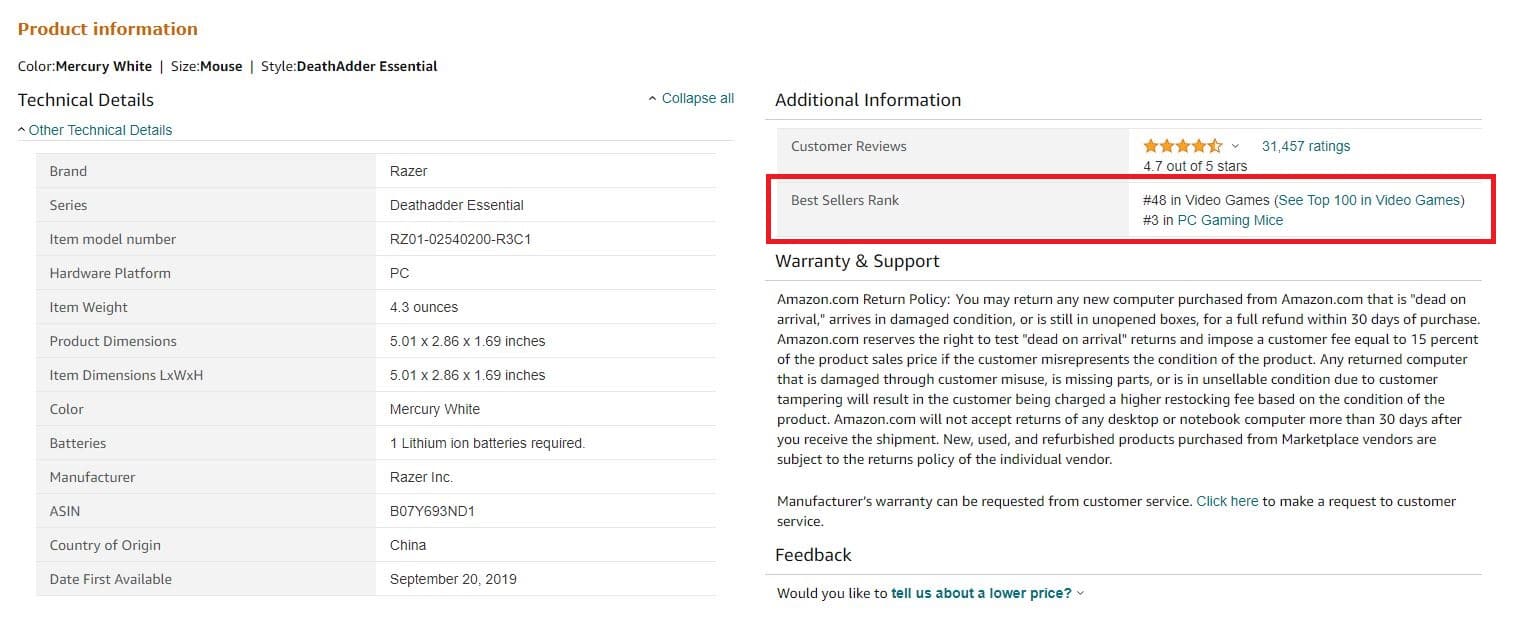
BSR is category-specific. One product can rank high in a certain category and not as good in another.
Your BSR also crops up in a number of other pages on the marketplace. These include Amazon's dedicated Best Sellers page and category-level Best Sellers pages, where they will rock a nice orange badge indicating their current rank within the category.
Related Reading: Amazon Badges and How to Get Them
The image below shows that our gaming mouse example shows up as #3 (as indicated in its Product Description) on Amazon's Best Sellers page for PC Gaming Mice.
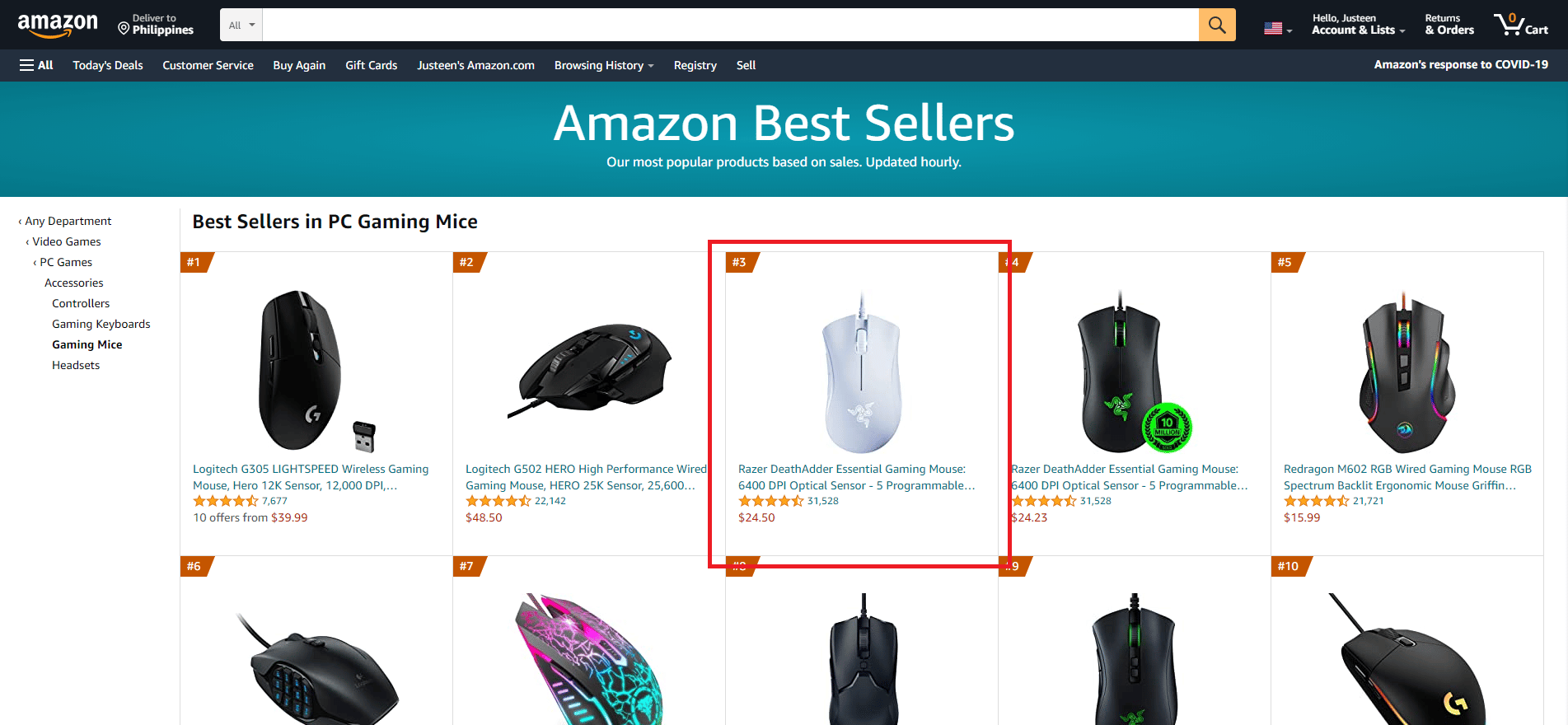
Amazon has a dedicated page for the Best Sellers in certain categories, which is updated constantly throughout the day.
In a lot of cases, if a search term coincides with a sub-category, the Best Seller for that category will show up often right next to the best-performing product in terms of organic rankings.
In the example below, the #1 Best Seller for Mac Gaming Mice shows up right below the Sponsored Products and Amazon's Choice for the particular search term.
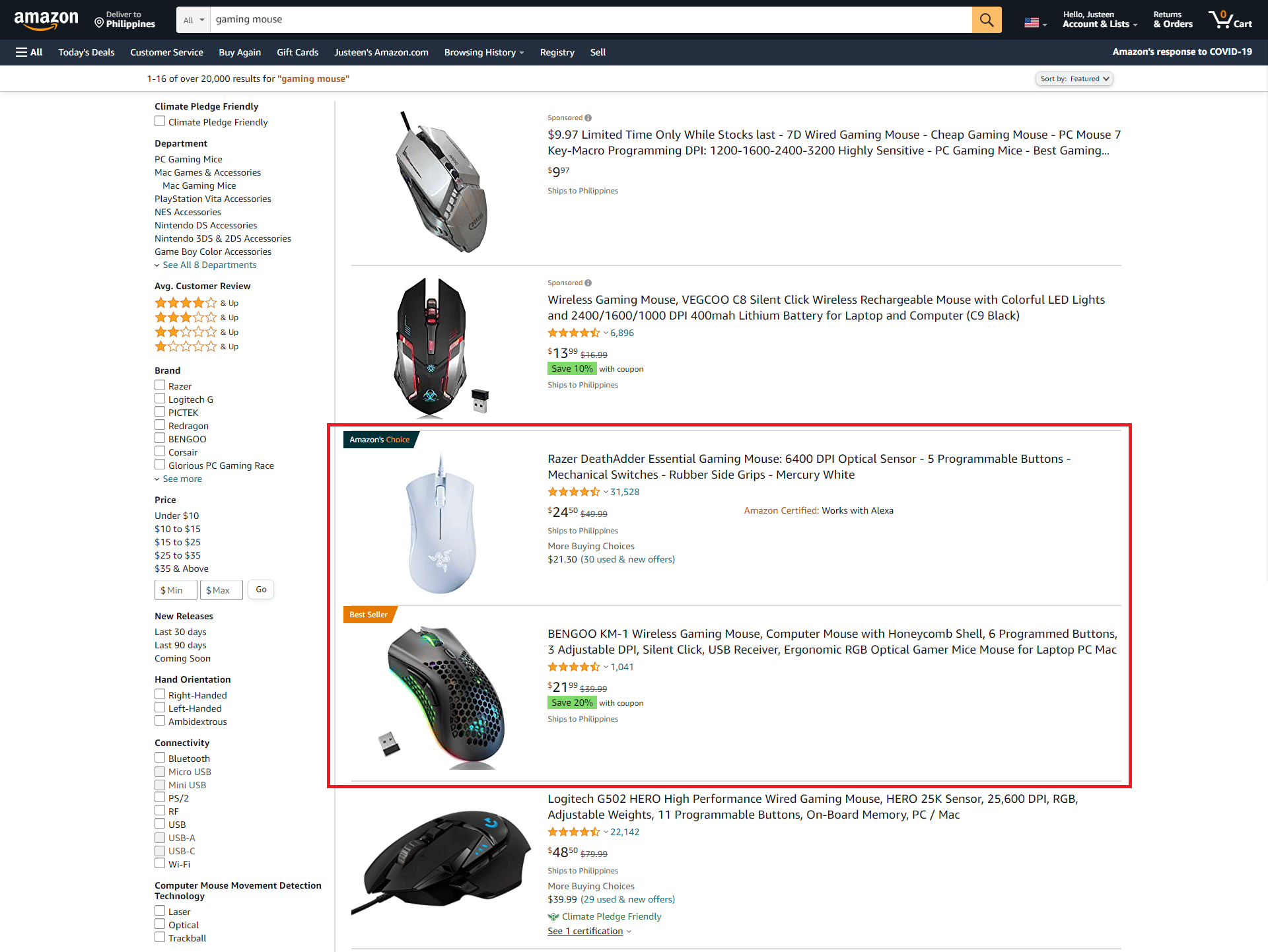
Best Sellers can show up in search results if the search term matches a relevant product category.
As a seller, you can view your product's sales rank within the Manage Inventory section on Seller Central. There are also third-party tools like JungleScout that can help you stay on top of your BSR, since doing so manually can get tricky and the rankings fluctuate hourly.
Best Sellers Rank vs Organic Search Rank
The Amazon Best Sellers Rank is not the same as your organic rank.
BSR is your product's ranking relative to other products in the same category based mainly on sales velocity, while organic ranking shows how well your listing performs for a certain search term or keyword.
Having a good BSR does not necessarily mean that your product will rank well for certain keywords.
If your product is the Best Seller, it gets that orange ribbon indicating its rank within a certain category. On the other hand, if your product is the best-performing listing for keywords it will get the black Amazon's Choice badge. The Amazon's Choice badge is prioritized in case your product has both badges at the same time.
While these two metrics don't directly influence each other, optimizing your listing for organic ranking is a surefire way to boost sales, and good sales volume means a higher BSR.
How is the Amazon Best Sellers Rank calculated?
In typical Amazon fashion, the exact formula for BSR remains a secret, but we do know that the BSR is updated hourly and is heavily influenced by sales volume.
According to JungleScout, other influencing factors include:
- Current and historic sales
- Product price changes and promotions
- Competitive products
Only one product can have the #1 Best Sellers Rank. And as you go higher up the ladder, it becomes progressively more difficult to rank up.
Since sales velocity is the name of the game for the Amazon Best Sellers Rank, you should also stay on top of factors like restock limits, product seasonality, and ASIN stockouts, as these can affect your inventory and cause dips in sales velocity.
What does the Amazon Best Seller Rank mean to sellers?
Here's the classic chicken-and-egg scenario for sellers: better sales lead to higher rankings, and higher rankings lead to more sales.
That being said, the Best Sellers Rank can be a good predictor of how well (or how poorly) a certain product is selling in its category.
JungleScout has a nifty sales estimator that gives you an idea of what your sales velocity is going to look like based on your Best Sellers Rank for a specific category.
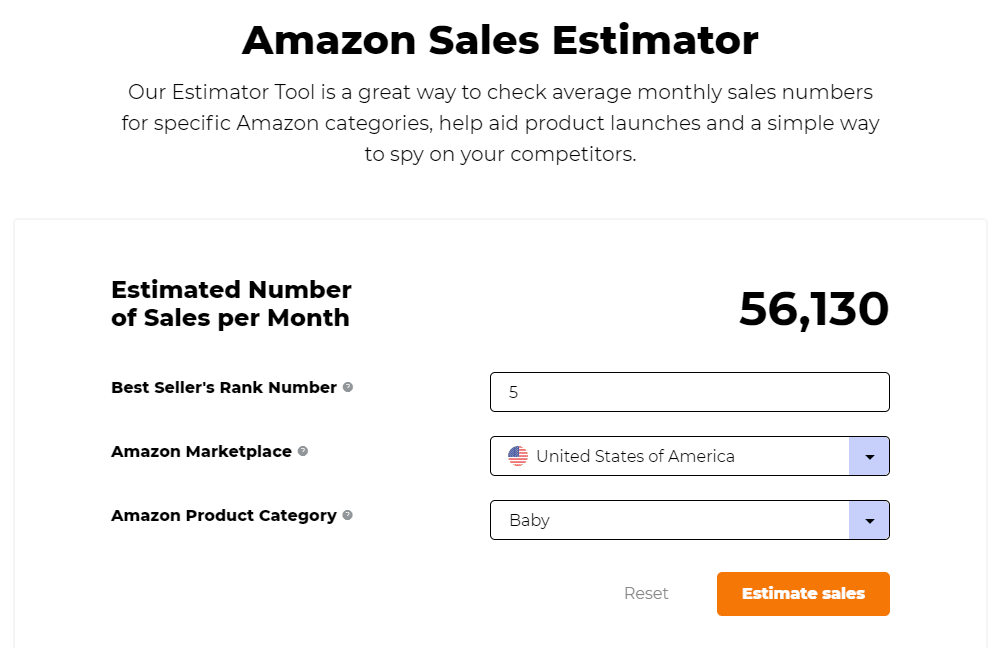
JungleScout's Sales Estimator gives you a glimpse of potential monthly sales based on category and ranking.
Keep in mind that most sales on Amazon go to the top-ranking products, and it falls rather sharply as you go lower in the rankings.
Below is an example of what sales you can expect as the #1, #5, #50, and #500 Best Seller in the Baby niche. It's clear that products belonging to the Top 50 Best Sellers eat up the majority of sales in their category.
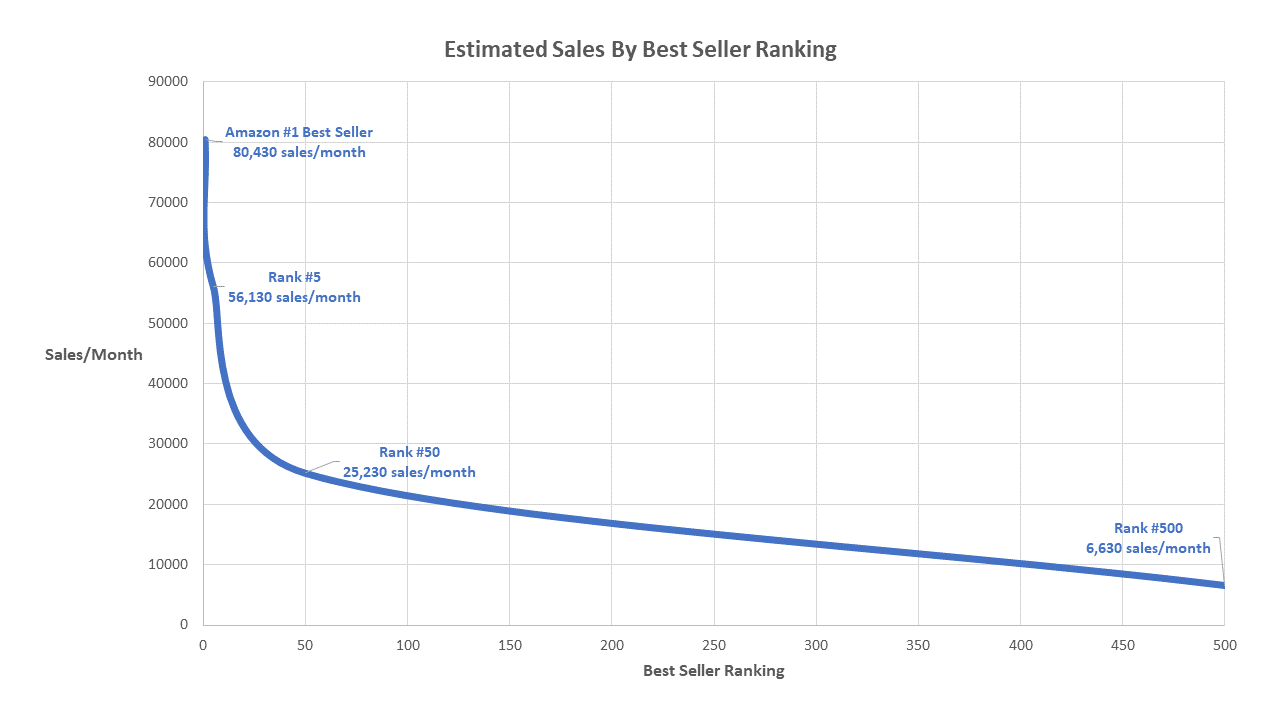
Estimated sales drop sharply the further you go down in the rankings.
Another advantage to ranking high on Amazon's Best Sellers is visibility and presentation. If your product is the #1 Best Seller in its category, it will automatically rock that nice orange ribbon, which is one of the most coveted Amazon Badges for third-party sellers. This attracts more customers and drives conversions.
Also keep in mind the additional placements you can snag on Amazon with a high BSR. For instance, Amazon has a dedicated page for the best sellers in various categories.
Lastly, and this means so much more if you're just starting out, the Best Sellers Rank can help you research which products on Amazon sell like hotcakes and have the highest demand on the marketplace. This can be useful even if you're currently selling on a non-Amazon platform.
For more experienced sellers, this helps when researching the competition. You can compare your product to the current best sellers in terms of specs and listings and make actionable decisions on how to drive your sales.
How do I improve my Amazon Best Sellers Rank?
We already know that BSR is category-based, so you want to strategize around appropriate categories for your products.
Strategize around categories. It's much easier to get a high BSR within categories with the least amount of competition and categories where your product can really stand out. But again, avoid listing your product under totally unrelated categories, as this can hurt more than it helps.
Get good product reviews. BSR is influenced by sales, and one way to boost sales is through positive customer feedback. Needless to say, most of the best sellers on the marketplace also boast great product reviews. Be sure to check out our updated Guide to Getting Amazon Product Reviews for all the ways to generate good reviews for your products. Some sellers focus on sheer review volume, while its all about those juicy 5-star ratings for others. It never hurts to have both.
Optimize your listing. Crafting a killer listing even before you launch your product can jumpstart your organic ranking and sales velocity (for a higher BSR). Make sure you have a great product title, bullet points, and high-quality images. If you're only just getting into Amazon, check out our full-length FBA for Absolute Beginners course so you can hit the ground running.
Remember sales velocity. The important thing to remember is that it's not enough to increase your sales to get a higher BSR, this increase should surpass your competitors' sales. This should go without saying, but if you're just getting into Amazon or are on Amazon and not already FBA, using Amazon's logistics service and Amazon Prime are huge drivers for sales. Another easy tweak to boost sales is to price your product competitively.
Generate content. Creating content around your product or private label brand also adds some social proof and improves customer perception, ultimately leading to better sales.
Final Thoughts
The Amazon Best Sellers Rank gives you an idea of how well your product is selling relative to your competitors'. Boosting your sales can help you get a good BSR, which can in turn lead to even more sales.
Has your product been Amazon's #1 Best Seller before? Tell us about your experience in the comments down below.
What Does Sales Rank Mean On Amazon
Source: https://www.ecomcrew.com/amazon-best-sellers-rank/
Posted by: jacksonpeand1935.blogspot.com

0 Response to "What Does Sales Rank Mean On Amazon"
Post a Comment